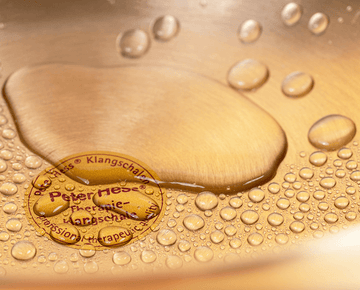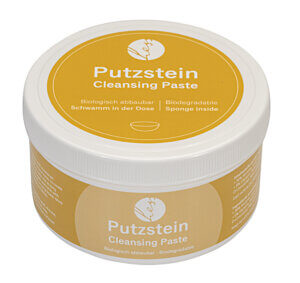
The most important facts in brief
- The metals from which a Singing Bowl is made can lead to corrosion.
- There is an effective cleaning method against the resulting stains.
- There are also several cleaning options for simple soiling.
- These methods have no effect on the sound of the bowl.
- You should always protect your Singing Bowl during storage and transportation.
Why are there stains on my Singing Bowl?
The different metals from which a Singing Bowl is made of, electrical voltages can arise. This results in the formation of galvanic elements and corrosion. However, contact with liquids containing salt or acid can also promote the corrosion process. This increases the amount of copper on the surface, which causes reddish-brown stains. The surface of Singing Bowls is normally impregnated after production so that it is at least temporarily protected. However, this is sometimes done carelessly or neglected, especially with very cheap Singing Bowls . This can lead to contamination during overseas transportation or through contact with sweat (on the hands).
Peter Hess® Therapy Singing Bowls with permanent coating
If you buy a Singing Bowl from our online store or showroom, you can be sure that it has been impregnated after production. We also offer a permanent coating for our Singing Bowls . The extremely thin, crystal-clear surface finish protects your Singing Bowl from oxidation, unsightly fingerprints and darkening for many years. This makes time-consuming cleaning a thing of the past.
We particularly recommend this option for Singing Bowls that are applied directly to the skin (possible contact allergies), that often need to be disinfected (for example in the medical field) or in combination with (salt) water. The vibrational properties of Singing Bowl remain completely unaffected by the treatment.
In our article "Production of Peter Hess® Therapy Singing Bowls" you can find out more about the advantages and areas of application of a Singing Bowl with a permanent coating. You can also explore the complex manufacturing process and learn more about the different quality levels.
How can I clean my Singing Bowl ?

Cleaning Singing Bowls for light soiling
For light soiling, you can also clean your Singing Bowl with normal washing-up liquid. A gentle brass cleaning milk can also be used. However, cleaning sponges should be avoided as they often leave scratch marks.
You can clean your Singing Bowl with these products:
- With a cleaning stone
- With washing-up liquid
- With a brass polish
Important note
We are not liable for damage caused by improper cleaning at Singing Bowls !
How are Singing Bowls traditionally cleaned?
In Nepal, traditional cleaning is carried out using a mixture of ash from rice straw and mustard oil. This is used to polish the bowl for several minutes. As these agents are not usually available to us here, we can fall back on some alternative cleaning methods.
How often should I clean my Singing Bowl and does this affect the sound?
Depending on how often a Singing Bowl is cleaned, its color can change over time. Which patina you prefer is of course a matter of taste. If you want to maintain the golden sheen, you should clean your Singing Bowl approximately every two months. We recommend regular cleaning and care, especially for frequently used therapy singing bowls.
Cleaning generally has no audible effect on the frequency behavior of the Singing Bowl. Minor changes in frequency could only occur if the Singing Bowl was constantly cleaned over a period of 20-30 years and some of the surface was removed in the process. But even this would not really be noticeable in everyday use.

Expert tip
If you have several Singing Bowls , avoid stacking them inside each other. Store your Singing Bowls individually and preferably wrapped in a soft cloth. Your bowl should be well protected, especially during transportation, for example with a singing bowl bag.






